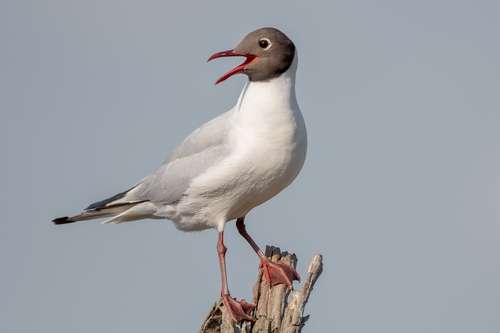
Black-headed Gull
The Black-headed Gull (Chroicocephalus ridibundus) is a small, elegant gull species widespread across Eurasia and parts of North America. It's known for its distinctive chocolate-brown hood during the breeding season, which fades to a dark smudge behind the eye in winter. This adaptable bird thrives in a variety of habitats, from coastal areas to inland wetlands and even agricultural fields. Ecologically, it plays a role in controlling insect populations and dispersing seeds. While not of major cultural significance, its presence is a familiar sight in many urban and rural environments, often scavenging for food near human activity.
34-43 cm
Length
86-99 cm
Wingspan
Least Concern
Conservation Status
Distribution
The Black-headed Gull breeds across much of Europe and Asia, extending from Iceland and the British Isles eastward to Kamchatka and northeastern China. It also has a small breeding population in eastern Canada. During the non-breeding season, it migrates south, reaching coastal regions of North Africa, the Middle East, South Asia, and Southeast Asia. Altitudinally, it ranges from sea level to about 1500 meters.
Lifespan
The average lifespan in the wild is around 10-15 years, but some individuals have been recorded living over 30 years.
Black-headed Gull's Habitat
Habitat Types
Coastal areas, Estuaries, Inland wetlands, Lakes and ponds, Marshes, Rivers, Agricultural fields, Urban parks
Climate Zones
Temperate, Boreal, Subarctic
Adaptations
Black-headed Gulls are highly adaptable to various food sources and habitat types. Their relatively small size and agile flight allow them to forage in diverse environments. They are also tolerant of human presence, often thriving in urban and suburban areas.
Variations
While generally considered monotypic (no recognized subspecies), some regional variations in size and plumage darkness have been noted, but these are not considered distinct enough to warrant subspecies classification.
Appearance
Breeding Plumage
Breeding adults have a distinctive chocolate-brown hood, white neck, and pale grey body. Non-breeding adults lose the hood, retaining only a dark smudge behind the eye. The legs and bill are red in breeding plumage, becoming duller in winter.
Seasonal Feather Changes
The most significant seasonal variation is the presence or absence of the brown hood. Juveniles have mottled brown and buff plumage, gradually acquiring adult plumage over 2-3 years.
Sex Based Plumage Differences
There is minimal sexual dimorphism in plumage, although males may have slightly brighter red legs and bills during the breeding season.
Notable Features
Chocolate-brown hood (breeding plumage), Dark smudge behind the eye (non-breeding plumage), Red legs and bill (brighter in breeding plumage), White outer primaries with black tips, Slender, pointed bill
Diet and Feeding
Primary Foods
Insects, Worms, Small fish, Crustaceans, Mollusks, Seeds, Berries, Carrion, Human refuse
Foraging Behavior
Black-headed Gulls are opportunistic feeders, employing a variety of foraging techniques. They may pick items from the ground, catch insects in flight, plunge-dive for fish, or scavenge for scraps. They often follow fishing boats or agricultural machinery to take advantage of disturbed prey.
Specializations
Their relatively slender bill is well-suited for catching small invertebrates and fish. They are also adept at aerial foraging, catching flying insects with agility.
Seasonal Diet Variations
Diet varies seasonally depending on prey availability. Insects are a major food source during the breeding season, while fish, crustaceans, and human refuse may be more important in winter.
Behavior
Social Structure
Black-headed Gulls are highly social birds, often forming large breeding colonies and foraging flocks. Outside the breeding season, they may gather in large roosts, sometimes numbering in the thousands.
Communication
A variety of calls, including a harsh 'kree-ar' and a repeated 'kwup', Visual displays, such as head-bobbing and wing-lifting, Aggressive postures, such as bill-pointing and chasing
Migration
Most populations are migratory, undertaking long-distance movements between breeding and wintering grounds. Migration routes vary depending on the breeding population, but generally follow coastlines or major river systems.
Territorial or Group Behaviors
During the breeding season, pairs defend small territories around their nests. Outside the breeding season, they are less territorial and often forage in mixed-species flocks.
Conservation
Threats
Habitat loss and degradation (wetlands, coastal areas), Pollution (pesticides, heavy metals), Disturbance at breeding colonies (human activity, predation), Climate change (sea level rise, altered prey distribution), Overfishing (reduced food availability)
Protection Programs
International agreements (e.g., Agreement on the Conservation of African-Eurasian Migratory Waterbirds - AEWA), National and regional protected areas (wetlands, coastal reserves), Habitat restoration projects
Local National Laws
Protected under various national and international wildlife legislation, such as the Migratory Bird Treaty Act in North America and the Birds Directive in the European Union.
Population Trend
Stable
Population Estimates
The global population is estimated to be 7.3 - 8.9 million individuals.
Interesting Facts
The 'black' head is actually a dark chocolate brown.
The color is only present during the breeding season; in winter, the head is mostly white with a dark smudge behind the eye.
They are known for their kleptoparasitic behavior.
They will often steal food from other birds, including other gulls and terns.
They can hybridize with other gull species.
Although rare, hybridization has been recorded with species like the Mediterranean Gull.
They are highly adaptable to urban environments.
They are commonly seen in cities and towns, scavenging for food in parks, landfills, and near human settlements.
Faqs about Black-headed Gull
What is the difference between a Black-headed Gull and a Laughing Gull?
Laughing Gulls have a truly black head during breeding season and a distinctive 'laughing' call. Black-headed Gulls have a chocolate-brown hood and different vocalizations.
Are Black-headed Gulls aggressive?
They can be aggressive when defending their nests and young, but are generally not a threat to humans.
Do Black-headed Gulls mate for life?
They are generally monogamous during a breeding season, but pair bonds may not always last for life. Divorce and re-pairing can occur.
Why do I see so many Black-headed Gulls inland?
While they are often associated with coasts, Black-headed Gulls are highly adaptable and can thrive in a variety of inland habitats, including lakes, rivers, and agricultural fields, especially during migration and winter.
Copyright @ Nature Style Limited. All Rights Reserved.
 English
English